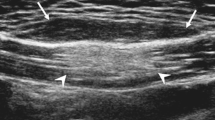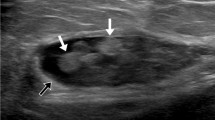Abstract
Objective
To analyze intramuscular soft-tissue tumors with fatty rind, and to evaluate the difference between fatty rind and split fat sign on magnetic resonance imaging (MRI).
Materials and methods
We retrospectively analyzed 50 pathologically confirmed intramuscular masses on MRI. We evaluated the distribution and shape of fatty rind and muscle atrophy.
Results
Fatty rind was found more frequently in benign lesions (80% [36 out of 45]) compared with malignant lesions (25% [1 out of 5]; P = 0.013). Thirty-six benign lesions were peripheral nerve sheath tumors (PNSTs; n = 19), hemangiomas (n = 11), myxomas (n = 2), ganglion cysts (n = 2), giant cell tumor (n = 1), and leiomyoma (n = 1). One malignant lesion was a low-grade fibromyxoid sarcoma. In all masses with fatty rind, fat was confined to the proximal and the distal ends. In 12 cases, complete or partial circumferential fatty rind was also noted. Fatty rinds at both ends showed crescent, triangular, or combined shape. The prevalence of crescent-shaped fatty rind was significantly higher in benign PNST (17 out of 38) compared with the other tumors (1 out of 32; P < 0.001). Complete circumferential fat was noted only in hemangioma (n = 5). Triangular fatty rind was related to peripheral location of the mass or muscle atrophy.
Conclusion
Most intramuscular tumors with fatty rinds were benign, and PNST was the most common tumor type. Fatty rind could be caused by displaced neurovascular bundle fat, fatty atrophy of the muscle involved, or intermuscular or perimysial fat. Crescent-shaped fatty rind was noted more frequently in benign PNSTs.




Similar content being viewed by others
References
Stull MA, Moser Jr RP, Kransdorf MJ, Bogumill GP, Nelson MC. Magnetic resonance appearance of peripheral nerve sheath tumors. Skeletal Radiol. 1991;20:9–14.
Abreu E, Aubert S, Wavreille G, Gheno R, Canella C, Cotten A. Peripheral tumor and tumor-like neurogenic lesions. Eur J Radiol. 2013;82:38–50.
Murphey MD, Smith WS, Smith SE, Kransdorf MJ, Temple HT. From the archives of the AFIP. Imaging of musculoskeletal neurogenic tumors: radiologic-pathologic correlation. Radiographics. 1999;19:1253–80.
Pilavaki M, Chourmouzi D, Kiziridou A, Skordalaki A, Zarampoukas T, Drevelengas A. Imaging of peripheral nerve sheath tumors with pathologic correlation: pictorial review. Eur J Radiol. 2004;52:229–39.
Chee DW, Peh WC, Shek TW. Pictorial essay: imaging of peripheral nerve sheath tumours. Can Assoc Radiol J. 2011;62:176–82.
Salunke AA, Chen Y, Tan JH, et al. Intramuscular schwannoma: clinical and magnetic resonance imaging features. Singapore Med J. 2015;56:555.
Shimose S, Sugita T, Kubo T, et al. Major-nerve schwannomas versus intramuscular schwannomas. Acta Radiol. 2007;48:672–7.
Zhang Z, Deng L, Ding L, Meng Q. MR imaging differentiation of malignant soft tissue tumors from peripheral schwannomas with large size and heterogeneous signal intensity. Eur J Radiol. 2015;84:940–6.
Bancroft LW, Kransdorf MJ, Menke DM, O’Connor MI, Foster WC. Intramuscular myxoma: characteristic MR imaging features. Am J Roentgenol. 2002;178:1255–9.
Luna A, Martinez S, Bossen E. Magnetic resonance imaging of intramuscular myxoma with histological comparison and a review of the literature. Skeletal Radiol. 2005;34:19–28.
Murphey MD, McRae GA, Fanburg-Smith JC, Temple HT, Levine AM, Aboulafia AJ. Imaging of soft-tissue myxoma with emphasis on CT and MR and comparison of radiologic and pathologic findings. Radiology. 2002;225:215–24.
Kransdorf MJ, Murphey MD. Imaging of soft tissue tumors. 2nd ed. Philadelphia: Lippincott Williams & Wilkins; 2006.
Olsen KI, Stacy GS, Montag A. Soft-tissue cavernous hemangioma. Radiographics. 2004;24:849–54.
Author information
Authors and Affiliations
Corresponding author
Ethics declarations
Conflicts of interest
The authors have no conflicts of interest to declare.
Funding
No funding was necessary to carry out this study.
Ethical approval
All procedures performed in studies involving human participants were carried out in accordance with the ethical standards of the institutional and/or national research committee and with the 1964 Declaration of Helsinki and its later amendments or comparable ethical standards.
Rights and permissions
About this article
Cite this article
Sung, J., Kim, JY. Fatty rind of intramuscular soft-tissue tumors of the extremity: is it different from the split fat sign?. Skeletal Radiol 46, 665–673 (2017). https://doi.org/10.1007/s00256-017-2598-5
Received:
Revised:
Accepted:
Published:
Issue Date:
DOI: https://doi.org/10.1007/s00256-017-2598-5




